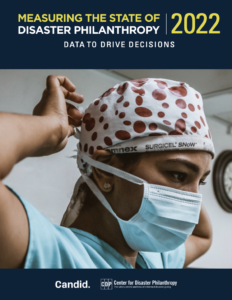My sister and I adhere to the concept of “showing up.” If a meal needs to be delivered because of sadness or sickness, we show up. If someone is amid one of life’s rough patches, we show up. If there is a reason to celebrate, we show up. It’s our thing.
In reflecting on philanthropy’s generosity in 2020, I just want to say to grantmakers and funders – You showed up powerfully and profoundly.
You showed up with financial support.
You showed up with your voice.
You showed up with your actions.
Philanthropy showed up with such generosity that the “B” word (billions) was used for the first time in my decades of working in disaster philanthropy. Let me explain.
 In our ninth annual research report, Measuring the State of Disaster Philanthropy 2022: Data to Drive Decisions, developed in partnership with Candid, we dive into how philanthropy and other funders supported natural hazards and severe weather events and complex humanitarian emergencies alongside the COVID-19 pandemic in 2020.
In our ninth annual research report, Measuring the State of Disaster Philanthropy 2022: Data to Drive Decisions, developed in partnership with Candid, we dive into how philanthropy and other funders supported natural hazards and severe weather events and complex humanitarian emergencies alongside the COVID-19 pandemic in 2020.
We examined nearly $121 billion in disaster giving, which went primarily toward COVID-19 response. Other key findings from our analysis of 2020 data include:
- Of the $5.2 billion in giving from foundations and public charities, 96% went toward epidemics, mainly for COVID-19 while the remainder supported wildfires, storms and other disaster efforts.
- The Organisation for Economic Co-operation and Development’s Development Assistance Committee (DAC) provided $36.4 billion in official development assistance. Non-DAC government funders and multilateral organizations contributed an additional $3.1 billion.
- The Federal Emergency Management Agency distributed $57.6 billion for U.S. disasters a $54 billion increase from 2019; the U.S. Department of Housing and Urban Development allocated $9 billion in recovery efforts in 2020, an $8 billion increase from 2019; and the U.S. Economic Development Administration invested approximately $1.2 billion in disaster-related projects. This is just a sampling of U.S. government contributions that make up the bulk of domestic disaster funds.
- Regrettably, 90% of foundation dollars went toward response and relief efforts, perpetuating the underfunding of recovery and reconstruction efforts.
As much as I am thankful for philanthropy’s extraordinary generosity in 2020, I’ll posit some cautionary thoughts. The nexus of climate change and natural hazards are becoming increasingly aligned. The philanthropic community must marshal all its financial resources for preparedness, event-driven efforts, and climate mitigation and adaptation. Those same financial resources are also needed to compel governmental bodies to fulfill the commitments made in the Sustainable Development Goals.
As we state in the report, “Now is the time to act. More money is needed, and yes, it needs to be all the things we have said before: equitable, flexible, locally based and focused on recovery. Funders need to prepare for the crises that are occurring in their communities and around the world. CDP has resources to help you get started. There is no better time to begin than now.”
One resource that CDP offers is our monthly webinar series. To learn more about how philanthropy can support true, long-term recovery and explore major findings from the report, I invite you to join us for the State of Disaster Philanthropy 2022: COVID-19 and beyond webinar in partnership with Candid and New York Life Foundation on Thursday, Nov. 17 at 2 p.m. ET.
Speakers include National Alliance for Children’s Grief’s Vicki Jay, Fidelity Charitable’s Elaine Martyn, Candid’s Grace Sato and CDP’s Tanya Gulliver-Garcia. They will share insights into the philanthropic and governmental response to disasters that occurred in 2020, such as the record-breaking Atlantic hurricane season, Cyclone Amphan, Puerto Rico’s earthquake swarm and Australia’s “Black Summer” wildfires of 2019-2020. They will explore the considerable difference between typical year-to-year disaster funding and the remarkable impact of COVID-19 on philanthropic giving, and the impact of disasters on grief and mental health.
Finally, we invite you to explore our updated funding map to answer questions such as: Where did funding for a particular disaster come from? How were the dollars allocated? How much funding addressed long-term recovery, preparedness and disaster risk reduction, in addition to immediate relief?
I will end with a few thank yous. Thanks to you for your interest in disaster philanthropy. Thank you to all the organizations that thoughtfully shared their data with Candid, which helped make this report and associated tools as robust as possible. Thanks, too, to the teams here at CDP and Candid who analyze the data, extrapolate its findings and make working with data exciting.
We all hope that Measuring the State of Disaster Philanthropy will give you the tools and insights to help make more informed and strategic disaster-related giving decisions. We hope this report and its recommendations serve as a reminder to philanthropy to “show up.”

